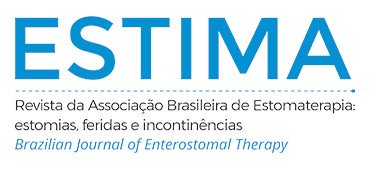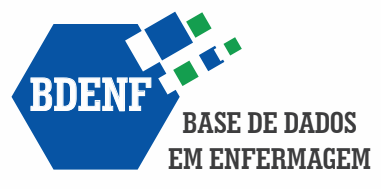CULTURAL ADAPTATION AND CONTENT VALIDITY OF MEDICAL ADHESIVE-RELATED SKIN INJURY FOR PORTUGUESE IN BRAZIL
Abstract
Objective: To culturally adapt the Medical Adhesive Related Skin Injury (MARSI) classification instrument to the Brazilian Portuguese and test the content validity of the adapted version. Method: Three phases comprised the cultural adaptation: translation, evaluation by a committee of judges composed of ten stomal therapists and back-translation. The project was approved by the Research Ethics Committee of the University of São Paulo. Results: A Portuguese version of the instrument was obtained after translation, which was guided by the Likert scale. The controversial and divergent terms were discussed by the committee of judges and their content was validated in a focus group, generating a content validity index of 0.9. The version was back-translated and approved by one of the instrument’s developer, who just suggested an adaptation to the concept of allergic contact dermatitis. Conclusion: The translated and culturally adapted version of MARSI classification instrument was obtained and its content validity attested. Tests regarding inter- and intra-observer reliability and concurrent validity are needed.
Downloads
Metrics
References
Domansky, RC, Borges, EL. Manual para prevenção de lesões de pele: Recomendações baseadas em evidências. 2aed. Rio de Janeiro: Rubio; 2017.
McNichol L, Lund C, Rosen T, Gray M. Medical adhesives and patient safety: State of the science consensus statements for the assessment, prevention, and treatment of adhesive-related skin injuries. J Wound Ostomy Continence Nurs 2013;40(4):365–80. https://doi.org/10.1097/NOR.0b013e3182a39caf
Zhao H, He Y, Wei Q, Ying Y. Medical adhesive related skin injury prevalence at the peripherally inserted central catheter insertion site: a cross-sectional, multiple-center study. J Wound Ostomy Continence Nurs 2018;45(1):22-5. https://doi.org/10.1097/WON.0000000000000394
Beeckman D, Campbell KE, LeBlanc K, Campbell J, Dunk AM, Harley C, et al. Best practice recommendations for holistic strategies to promote and maintain skin integrity. Wounds Int 2020;32.
Fumarola S, Allaway R, Callaghan R, Collier M, Downie F, Geraghty J, et al. Overlooked and underestimated: medical adhesive-related skin injuries. Best practice consensus document on prevention. J Wound Care 2020;29(Suppl. 3):S1-S24. https://doi.org/10.12968/jowc.2020.29.Sup3c.S1
Collier M. Minimising pain and medical adhesive related skin injuries in vulnerable patients. Br J Nurs 2019;28(15):S26-S32. https://doi.org/10.12968/bjon.2019.28.15.S26
Zhao H, He Y, Huang H, Ling Y, Zhou X, Wei Q, et al. Prevalence of medical adhesive-related skin injury at peripherally inserted central catheter insertion site in oncology patients. J Vasc Access 2018; 19(1):23-7. https://doi.org/10.5301/jva.5000805
McNichol L, Bianchi J. Medical adhesive-related skin injuries (MARSI) - made easy. Wounds UK 2016;12(4):1-4.
O’Flynn SK. Peristomal skin damage: assessment, prevention and treatment. Br J Nurs 2019;28(5):S6-S12. https://doi.org/10.12968/bjon.2019.28.5.S6
Gao C, Yu C, Lin X, Wang H, Sheng Y. Incidence of and risk factors for medical adhesive-related skin injuries among patients: A cross-sectional study. J Wound Ostomy Continence Nurs 2020;47(6):576-81. https://doi.org/10.1097/WON.0000000000000714
Ratliff CR. Descriptive study of the frequency of medical adhesive–related skin injuries in a vascular clinic. J Vasc Nurs 2017;35(2):86-9. https://doi.org/10.1016/j.jvn.2017.01.001
Farris MK, Petty M, Hamilton J, Walters SA, Flynn MA. Medical adhesive-related skin injury prevalence among adult acute care patients. A single-center observational study. J Wound Ostomy Continence Nurs 2015;42(6):589-98. https://doi.org/10.1097/WON.0000000000000179
Konya C, Sanada H, Sugama J, Okuwa M, Kamatani Y, Nakagami G, et al. Skin injuries caused by medical adhesive tape in older people and associated factors. J Clin Nurs 2010;19(9-10):1236-42. https://doi.org/10.1111/j.1365-2702.2009.03168.x
Koval KJ, Egol KA, Polatsch DB, Baskies MA, Homman JP, Hiebert RN. Tape blisters following hip surgery: A prospective, randomized study of two types of tape. J Bone Joint Surg Am 2003;85(10):1884-7.
Habiballah L. Prevalence of neonate adhesive skin injuries in a Jordanian intensive care unit. Nursing children and young people (2014+), 29 (10), 42. https://doi.org/10.7748/ncyp.2017.e966
Wang D, Xu H, Chen S, Lou X, Tan J, Xu Y. Medical adhesive-related skin injuries and associated risk factors in a pediatric intensive care unit. Adv Skin Wound Care 2019;32(4):176-82. https://doi.org/10.1097/01.ASW.0000553601.05196.fb
Paiva DRO, Simino GPR. Incidência de lesões cutâneas relacionadas à adesivos médicos em uma unidade coronariana [monografia de especialização]. Belo Horizonte (MG): Universidade Federal de Minas Gerais; 2018.
Alcantara CMP, Oliveira ELS, Campanili TCGF, Santos RSCS, Santos VLCG, Nogueira PC. Prevalência de lesão de pele relacionada a adesivos médicos e fatores associados em unidades críticas cardiológicas. Rev Esc Enferm USP. 2021;55. https://doi.org/10.1590/S1980-220X2019035503698
Oliveira, ELS. Prevalência e fatores associados de lesão de pele relacionada a adesivos médicos em pacientes críticos: estudo multicêntrico [dissertação]. São Paulo (SP): Escola de Enfermagem, Universidade de São Paulo; 2021.
Maene B. Hidden costs of medical tape-induced skin injuries. Wounds UK. 2013;9(1):46-50.
Beaton D, Bombardier C, Guillemin F, Ferraz MB. Recommendations for the cross-cultural adaptation of the DASH & QuickDASH outcome measures. Inst Work Health 2007;46.
Quatrini Carvalho Passos Guimarães HC, Pena SB, Lopes J de L, Lopes CT, Bottura Leite de Barros AL. Experts for validation studies in nursing: New proposal and selection criteria. Int J Nurs Knowl 2015;27(3):130-5. https://doi.org/10.1111/2047-3095.12089
Likert R. A technique for the measurement of attitudes. Arch Psychol 1932;22(140):1-53.
Alexandre NMC, Gallasch CH, Lima MHM, Rodrigues RCM. A confiabilidade no desenvolvimento e avaliação de instrumentos de medida na área da saúde. Rev Eletr Enferm 2013;15(3):800-7. https://doi.org/10.5216/ree.v15i3.20776
Downloads
Published
How to Cite
Issue
Section
License
Copyright (c) 2023 Evellyn Lima da Silva Oliveira, Magali Thum, Pollyanna Santos Carneiro da Silva, Paula Cristina Nogueira , Vera Lúcia Conceição de Gouveia Santos

This work is licensed under a Creative Commons Attribution 4.0 International License.

























